|
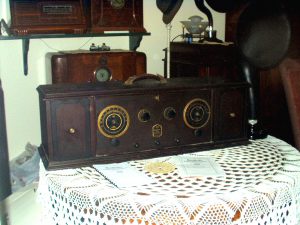
Here we have a 1924 RCA Radiola AR-812 Superheterodyne. Bought this at a swapmeet recently. Considered the
world's first superheterodyne, this receiver was meant to be portable, but it is over 4 feet long and weighs about 50 pounds
without batteries (try lugging this thing around like I did, and you will rethink the word "portable"). Has a built-in
antenna so needs no outside antenna or ground. Will work with a horn speaker such as the Radiola UZ-1325 shown next
to it. Also shown with the owner's manual, service manual, and 4 spare paper dial inserts. Getting a little hard
to find nowadays, but they are out there. Be prepared to pay a great deal more than the book calls for if
you buy it from a knowledgeable dealer or in an on-line auction. Best to find one at a garage sale or a swapmeet.
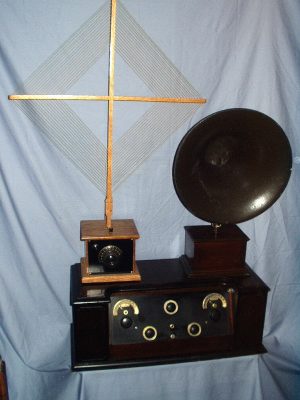
One of my favorites, and a daily user. A 1924 Crosley Trirdyne Super Special 3 tube battery radio (yes, as big
as this thing is, it only has 3 tubes!). Shown with a 1923 Kellogg Special horn speaker and a period tuned loop
antenna I built myself using oak, 1920's tuning condenser, and litz wire. I think that this is one of the most beautiful
1920's Crosley table radios made.
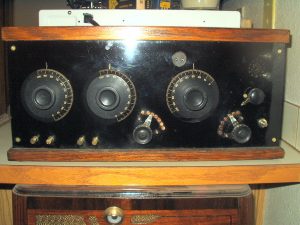
A homebuilt 1 tube battery radio. According to the very old, very tattered note written by the builder inside with
hand-drawn schematic, it was built in April 1918, and rebuilt in 1923. Uses an 01A tube, multi-tapped coil with variometer,
button grid leak mounted on front panel, and TWO tuning condensers (unusual for a 1 tube radio, 1 condenser is for antenna
tuning). I think this guy did a pretty nice job building it, as the interior is as neatly laid out and assembled as
the front panel. Usually, homebuilt radios don't look this good. When I got this one, I immediately
hooked it up to my battery eliminator and an antenna, donned some earphones, and viola!, it worked!
|
 |
|
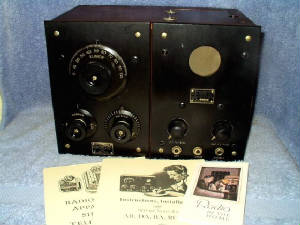
My 1921 Westinghouse RC (RA/DA) 3 tube broadcast/Shortwave reciever. Shown with the RC (RA/DA) instruction manual,
a 1921 Westinghouse radio apparatus catalogue (this model, along with it's accessories, is in it), and a brochure
on the RC (RA/DA), (with a Seattle radio store with address and phone number stamped on the back). More info on
this reciever can be found on my history and background page.
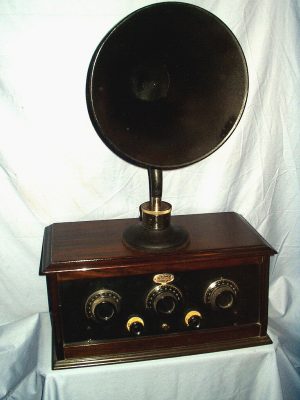
A 1925 Federal A-10 Orthosonic 5 tube battery radio. The only Federal I own (wish I had more, but I'm not rich). Federal
started out as a telephone company and making telephones and equipment. By 1922, they were making radio sets, and by
1925 their sets were amongst the best on the market, and very expensive. The A-10 Orthosonic was one of their crowning
acheivements in radio up to that time. Better sets would come later. However, Federal also became one of the victims
of cheaper radios and the stock market crash, and closed their doors in bankrupcy in July 1929. Federal radio sets and
accessories are amongst the most sought after by collectors as well as the most expensive, and luckily, I got this one from
an uninformed seller for very little. Anymore, anything (even telephones!) made by Federal is hard to come by, and you
must do battle with everyone else to get one, and mortgage your house to pay for it. Shown here with a Rola Recreator
horn speaker, also from 1925.
|
 |
|
|
 |
|
|
|

